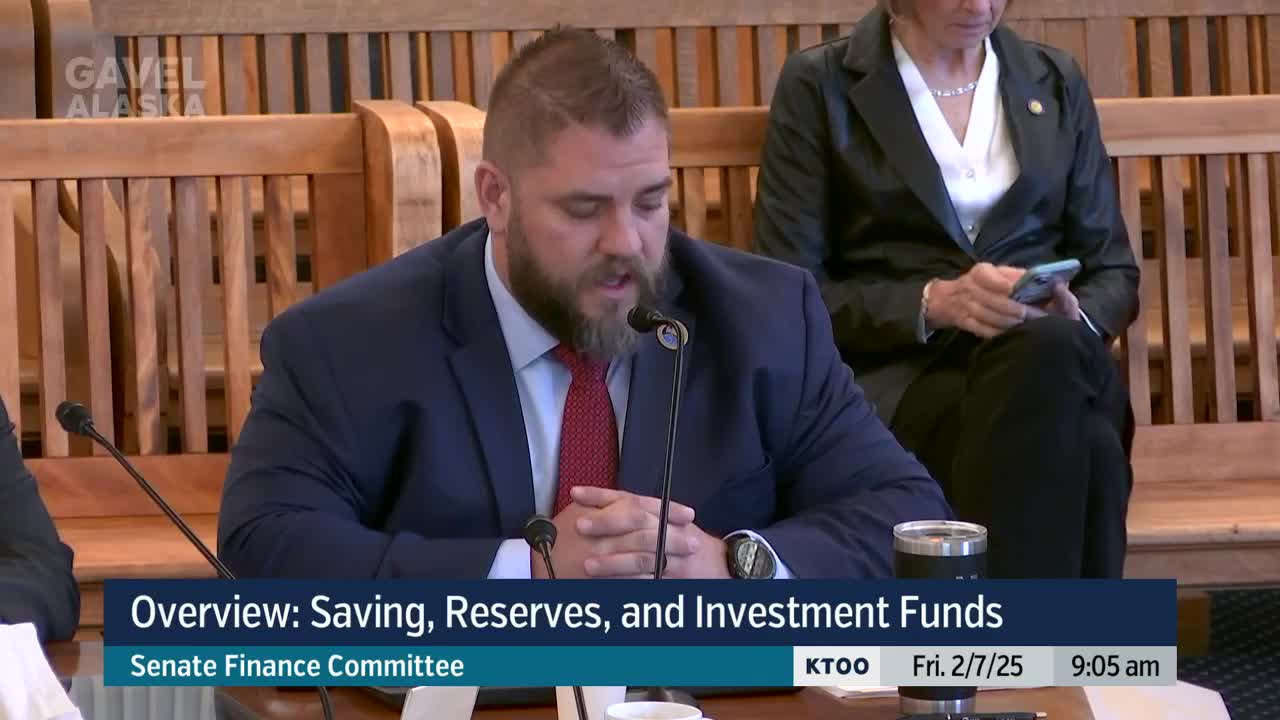Alaska Treasury reports $9 billion gains and cash management strategies for state funds
February 07, 2025 | Finance, Standing Committees, Senate, Committees, Legislative, Alaska
This article was created by AI summarizing key points discussed. AI makes mistakes, so for full details and context, please refer to the video of the full meeting. Please report any errors so we can fix them. Report an error »

The Senate Finance Committee meeting held on February 7, 2025, focused on the financial management of Alaska's state funds, highlighting significant gains in investment accounts and the complexities of cash management.
During the meeting, Treasury Division Director Pam Leary reported that as of the close of fiscal year 2024, Alaska's assorted investment accounts had gained $580 million, with long-term funds achieving returns exceeding 13%. The Alaska Retirement Management Board's assets also saw substantial growth, totaling $43 billion with a 9% return that surpassed actuarial expectations.
Leary emphasized the importance of the Treasury's daily cash management, which involves overseeing cash flows and ensuring sufficient balances in the general fund to meet state obligations. The Treasury Division manages approximately $50 billion across various investment funds, executing around 80,000 trades annually. The division is structured into four main sections: portfolio management, accounting and operations, compliance and performance reporting, and cash management.
The cash management team plays a crucial role in processing over 100,000 transactions each year, which include managing inflows from tax revenues and federal programs, as well as outflows for payroll and other state expenses. Leary noted that Alaska's constitutional budget reserve fund is among the highest in the nation, providing a buffer against revenue volatility, particularly from oil prices.
Senator Stedman raised concerns about the volatility of Alaska's revenue streams, primarily dependent on oil, compared to more stable sources like property and sales taxes in other states. Leary acknowledged this volatility but pointed out that investment earnings are becoming a more significant portion of the state's unrestricted general fund revenue, projected to account for about 60% in fiscal year 2025.
The meeting underscored the ongoing challenges and strategies in managing Alaska's financial resources, particularly in light of fluctuating oil prices and the need for effective cash flow management. The discussions set the stage for future financial planning and policy considerations as the state navigates its economic landscape.
During the meeting, Treasury Division Director Pam Leary reported that as of the close of fiscal year 2024, Alaska's assorted investment accounts had gained $580 million, with long-term funds achieving returns exceeding 13%. The Alaska Retirement Management Board's assets also saw substantial growth, totaling $43 billion with a 9% return that surpassed actuarial expectations.
Leary emphasized the importance of the Treasury's daily cash management, which involves overseeing cash flows and ensuring sufficient balances in the general fund to meet state obligations. The Treasury Division manages approximately $50 billion across various investment funds, executing around 80,000 trades annually. The division is structured into four main sections: portfolio management, accounting and operations, compliance and performance reporting, and cash management.
The cash management team plays a crucial role in processing over 100,000 transactions each year, which include managing inflows from tax revenues and federal programs, as well as outflows for payroll and other state expenses. Leary noted that Alaska's constitutional budget reserve fund is among the highest in the nation, providing a buffer against revenue volatility, particularly from oil prices.
Senator Stedman raised concerns about the volatility of Alaska's revenue streams, primarily dependent on oil, compared to more stable sources like property and sales taxes in other states. Leary acknowledged this volatility but pointed out that investment earnings are becoming a more significant portion of the state's unrestricted general fund revenue, projected to account for about 60% in fiscal year 2025.
The meeting underscored the ongoing challenges and strategies in managing Alaska's financial resources, particularly in light of fluctuating oil prices and the need for effective cash flow management. The discussions set the stage for future financial planning and policy considerations as the state navigates its economic landscape.
View full meeting
This article is based on a recent meeting—watch the full video and explore the complete transcript for deeper insights into the discussion.
View full meeting
